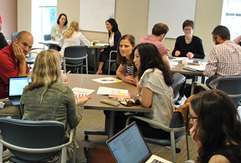Peer-Observation Instructions
The ECO-STEM Peer Observation Tool can be used to get information on how your class is working through a second set of eyes. When used with a peer for a peer observation, each instructor will observe the other.

|
Step 1: (Each instructor individually)
Familiarize yourself with the tool by using the summary version of the observation tool. It is broken into the three areas of climate, structure, and vibrancy. You may have identified an aspect of your class that you want to change – think about which of the observable behaviors of students and faculty relate to that aspect. Narrow down your list to 10-15 observable behaviors. For more information on any of the observable behaviors, please see the corresponding entry in the Eco-STEM repository. |

|
Step 2: Meet with your peer observer (whom you will observe in turn). Discuss your overarching goals for the observation and the list of observable behaviors you want to focus on. Together with the observer, narrow down the list to around 10 observable behaviors (at least 2 or 3 from each Indicator (Climate, Structure, Vibrancy), using the feedback from the discussion with the peer observer who may have given feedback on additional/alternative ways you could get at your goal.
Step 3: Now work through the observer’s list of observable behaviors and be a sounding board for your partner. Assist your partner in narrowing down his/her list to 10 observable items. If the class to be observed is taught online, then make sure to select behaviors that can be observed in that environment and arrange for the observer to be able to access your class. Create a tailored observation form with only your selected behaviors that your peer can use in the observation. |

|
Step 4: Identify dates and times for the classes in which you will observe each other, and also select a date for debrief after both observations have taken place. |

|
Step 5: Visit and observe each other’s classes using each other's tailored observation forms. |

|
Step 6: Meet to debrief. Exchange your completed observation tools with your respective assessments on how prevalent the selected behaviors were during the observations, and any additional notes the observer made. If during the discussion, areas of growth are identified, then the Eco-STEM repository can be a useful resource providing research articles or examples on how one might implement specific strategies. |
If you find that there are principles or behaviors you would like to find out more about, such as research articles or examples on how one might implement particular strategies, then head over to the Eco-STEM Repository, which is organized in the same way as the Peer Observation Tool. If you have items to contribute, please create an account in The Eco-STEM Wiki and add your contribution to the relevant page.